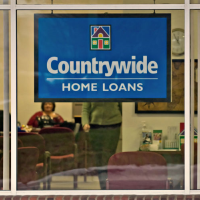Nonbank Lenders Who Again Dominate the Mortgage Market Look Familiar
 (photo: Bloomberg)
(photo: Bloomberg)
After the housing meltdown in 2006, fueled in no small measure by the reckless subprime lending of Southern California’s Countrywide Financial Corp. to just about any lower-income borrower that asked, the company was essentially put out of business and the executives responsible were sent to jail.
That’s all true except for the last part. The executives were not punished and now run large nonbank companies in Southern California that specialize in the low end of the housing market, like Countrywide did, according to the Los Angeles Times. They have an even larger share of the housing-loan market than pre-crash.
As long as home prices keep going up, these companies—fueled by hedge funds, initial public offerings (IPOs), private equity firms and lots of debt—help to re-inflate the housing bubble. Nonbank lenders, which specialize in loans to the less fortunate, saw their 31% share of the home-loan market in 2005 decline to 10% by 2009.
But they made a dramatic comeback and were responsible for 41% of home loans last year. Banks, under the scrutiny of government regulators, have toughened credit requirements and backed away from the kind of loans that have fueled the growth of nonbanks.
A Times analysis of financial data found that nonbank loans were 23% more likely to go sour than bank loans.
“One man's trash is another man's treasure,” Freedom Mortgage Chief Stanley Middleman told the Wall Street Journal last year. “If the banks were not going to fill this requirement in our economy . . . we wanted our market share to go up as those opportunities in origination arise.” Freedom is not one of the Countrywide-stocked companies.
Those companies are PennyMac, AmeriHome Mortgage and Stearns Lending, three of the nation’s largest housing lenders. They are subject to less regulation than banks, answering to the Consumer Financial Protection Bureau and state regulators. But they are not regulated by the Federal Reserve, Federal Deposit Insurance Corporation or Comptroller of the Currency.
Rules for subprime loans, and home loans in general, have been tightened up to seemingly contain the excesses of the pre-crash years. Alternative lenders have turned to loans insured by the Federal Housing Administration (FHA) and Department of Veterans Affairs (VA).
FHA loans have a lower down payment than conventional loans (3.5%, not 20%), but have borrowing limits and require that mortgage insurance be taken out. The borrower can have a credit score as low as 580. The average FICO score for those getting conventional loans is 755; it’s 689 for FHA.
The mortgage lending business has changed since 2005. The banking industry is more heavily capitalized, lending rules are tighter and regulators are said to be warier than ever. The bankers’ retreat has realigned the lending industry, shifting riskier loans to businesses operating in the shadow economy, where regulators are held at arms length and debt is leveraged at levels frowned upon elsewhere.
In a speech (pdf) in April, Senator Elizabeth Warren (D-Massachusetts) warned, “Shadow banking was a significant part of the crash in 2008, creating runs and panics in short-term debt markets that spread the contagion across the financial system.” Economist Paul Krugman, who said the shadow banking system was at the heart of the housing crash, has suggested, “Anything that has to be rescued in crises the way banks are, should be regulated like a bank.”
We are moving in the opposite direction. Some of the rules are different now, but many of the players, seasoned and savvier than ever, are the same. It remains to be seen how the outcome of the game will be affected.
–Ken Broder
To Learn More:
After Subprime Collapse, Nonbank Lenders Again Dominate Riskier Mortgages (by James Rufus Koren, Los Angeles Times)
Subprime “Alt”-Mortgages from Nonbanks, Run by Former Countrywide Execs, Backed by PE Firms Are Hot Again (by Wolf Richter, Wolf Street)
Like a Zombie, You Just Can't Kill Countrywide Financial (by Kevin Drum, Mother Jones)
Why Big Banks Are Losing Out to Nonbank Lenders in Mortgages (by Kathleen Pender, San Francisco Chronicle)
Nonbank Mortgage Lenders Bounce Back (by Joe Light, Wall Street Journal)
- Top Stories
- Controversies
- Where is the Money Going?
- California and the Nation
- Appointments and Resignations
- Unusual News
- Latest News
- California Forbids U.S. Immigration Agents from Pretending to be Police
- California Lawmakers Urged to Strip “Self-Dealing” Tax Board of Its Duties
- Big Oil’s Grip on California
- Santa Cruz Police See Homeland Security Betrayal in Use of Gang Roundup as Cover for Immigration Raid
- Oil Companies Face Deadline to Stop Polluting California Groundwater





